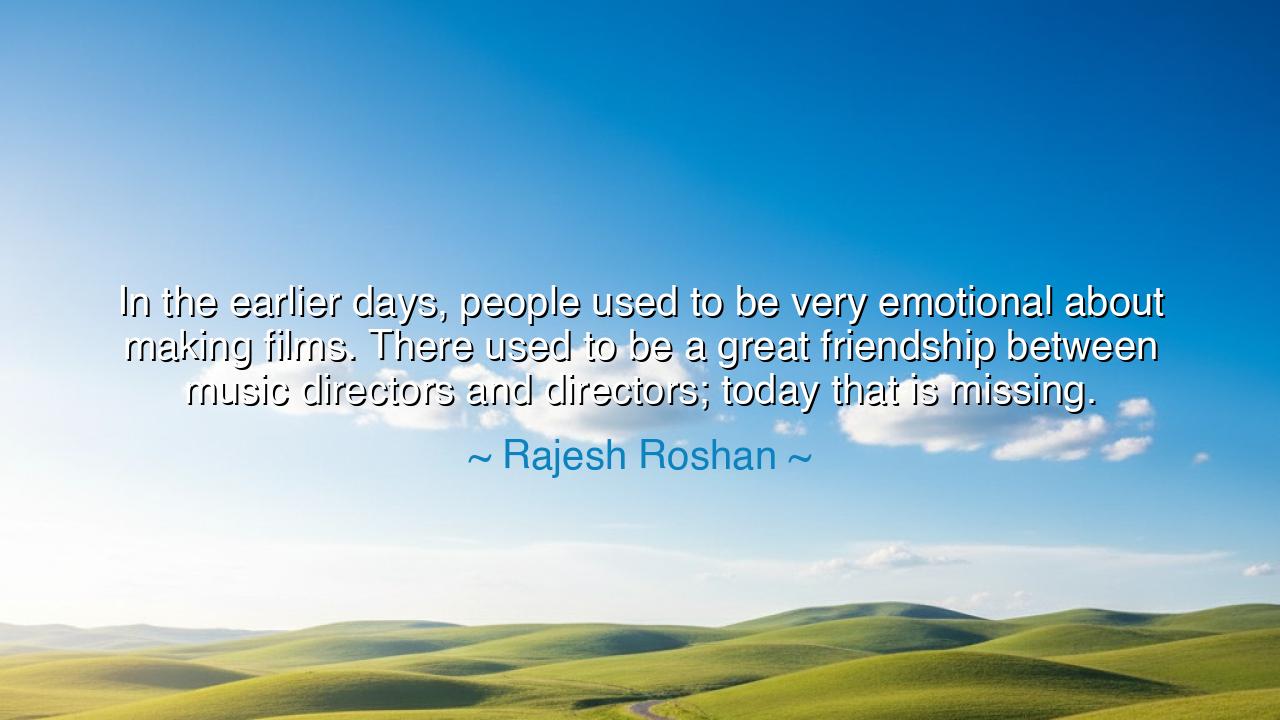
In the earlier days, people used to be very emotional about
In the earlier days, people used to be very emotional about making films. There used to be a great friendship between music directors and directors; today that is missing.






In the wistful yet truthful words of Rajesh Roshan, we hear the lament of an artist who has seen the changing tides of creation: “In the earlier days, people used to be very emotional about making films. There used to be a great friendship between music directors and directors; today that is missing.” Though spoken of cinema, his words reach far beyond the screen, touching the eternal story of human endeavor — the fading bond between art and emotion, collaboration and friendship. Roshan’s reflection is not a complaint, but an elegy — a remembrance of a time when creation was a shared heartbeat, not a calculated enterprise. He speaks as one who has witnessed the transformation of art into industry, and who mourns the loss of that sacred camaraderie which once breathed life into the soul of storytelling.
In the earlier days of Indian cinema, as Roshan recalls, the making of a film was not merely a profession; it was a pilgrimage. Directors and music composers, actors and lyricists, did not meet in conference rooms or over contracts, but in moments of shared inspiration. The friendship between these creators was not born of business, but of devotion — a mutual trust that allowed music to flow like water into the heart of a story. Together, they dreamt, argued, wept, and rejoiced; they were co-architects of emotion. In those days, as Roshan says, people were “emotional about making films” because art itself was an act of love — a union of souls seeking to touch eternity through melody and light.
Think of the golden age of cinema, when legends such as S.D. Burman and Guru Dutt worked in deep harmony. Burman’s haunting melodies did not merely accompany Dutt’s films; they became them. Each song, like a sigh or a prayer, carried the pulse of its story — “Jaane Woh Kaise Log The” from Pyaasa, for instance, was not just music but the echo of a poet’s despair, woven seamlessly into Dutt’s vision. Such collaborations were not bound by commercial goals, but by shared emotion and trust. They were friendships in their truest form — friendships of the spirit.
Roshan’s sorrow, then, is not nostalgia for the past, but a warning for the present. He reminds us that in a world increasingly driven by speed and profit, friendship and feeling — the lifeblood of art — are being replaced by convenience and calculation. Where once a director and composer would sit together, searching for the soul of a scene, now algorithms and markets dictate what the audience “wants.” The sacred fire of collaboration flickers in the winds of modernity. When art loses its intimacy, it loses its humanity; and when creation is no longer born from emotion, it ceases to move the heart.
This truth extends beyond cinema. Every craft — whether painting, science, or leadership — begins to wither when relationships are stripped of warmth and sincerity. The ancients knew this well. The sculptor Phidias, who carved the stones of the Parthenon, worked not alone but with fellow artisans bound by mutual respect and purpose. Their friendship infused the marble with life; their unity made beauty eternal. When artists cease to feel for one another, their works become hollow, however perfect their form. Roshan’s words remind us that friendship is not an ornament of creation — it is its foundation.
Yet, his lament carries also a hidden hope. For if something has been lost, it can be found again. The way back to emotional art lies in rekindling the human connection at its heart. Let the music director and filmmaker, the writer and the painter, once more sit together — not as business partners, but as friends and dreamers. Let them speak not first of profit, but of beauty. Let them remember that to create something truly timeless, one must first feel. For friendship is the bridge through which inspiration passes from one soul to another, and through that bridge, art becomes immortal.
So, O listener, let this teaching be your own: whatever your work, let it be guided not only by skill, but by relationship and emotion. Cherish those who walk beside you in your craft. Be loyal to your collaborators. Seek friendship over rivalry, purpose over ambition. For a creation born in friendship will outlive the age that made it. As Roshan reminds us, the heart is the oldest instrument, and only when it beats in harmony with others can it make music that the world will remember.
And thus, may we raise not only our voices but our spirits — in gratitude for the friendships that shape our art, and in remembrance of those golden days when the making of something beautiful was, above all, an act of love.






AAdministratorAdministrator
Welcome, honored guests. Please leave a comment, we will respond soon